人教版(2019)必修第二册Unit 4History and traditions Reading and thinking 课件(共28张ppt)
文档属性
| 名称 | 人教版(2019)必修第二册Unit 4History and traditions Reading and thinking 课件(共28张ppt) |  | |
| 格式 | zip | ||
| 文件大小 | 6.9MB | ||
| 资源类型 | 教案 | ||
| 版本资源 | 人教版(2019) | ||
| 科目 | 英语 | ||
| 更新时间 | 2022-07-14 15:53:24 | ||
图片预览

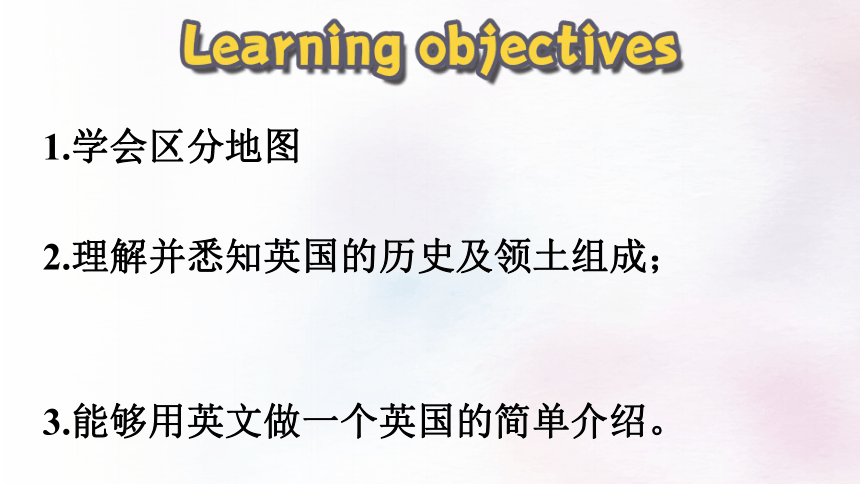

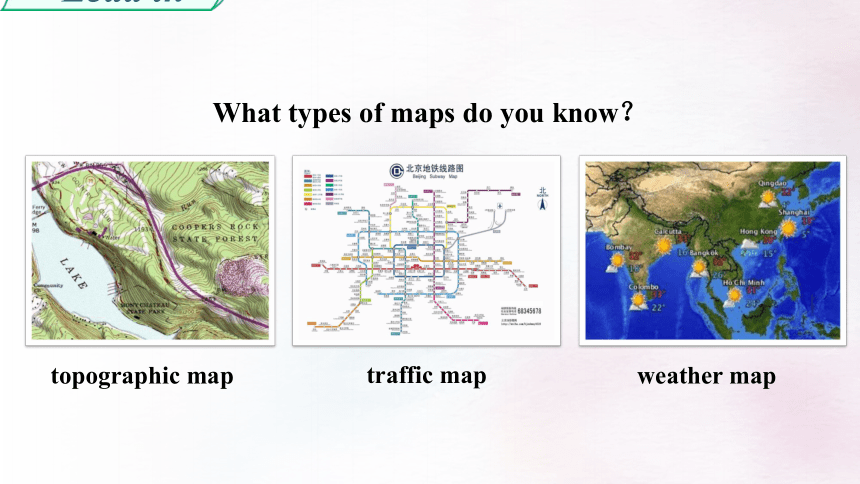
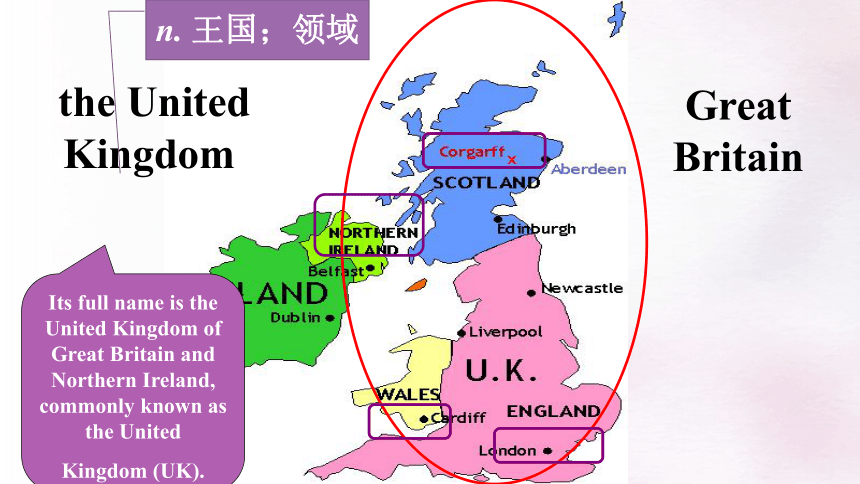
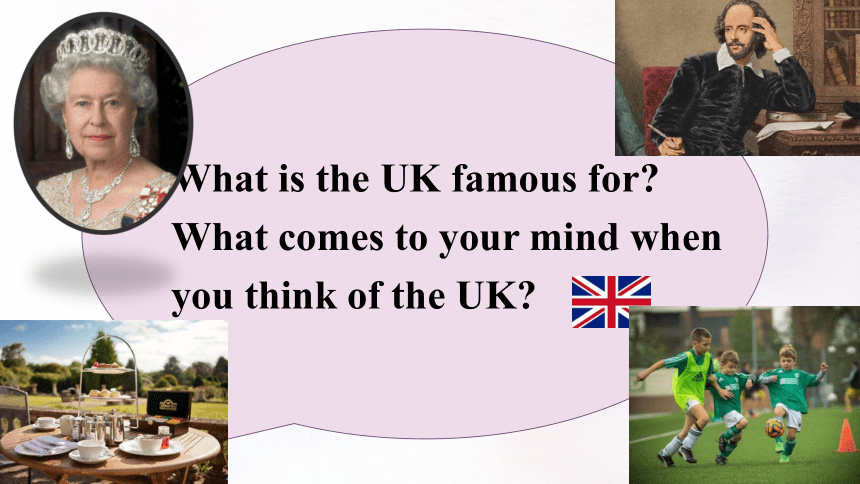

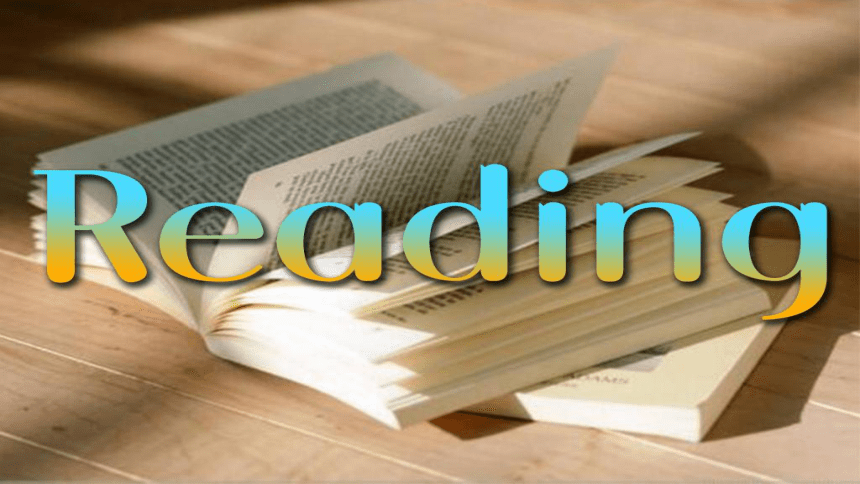
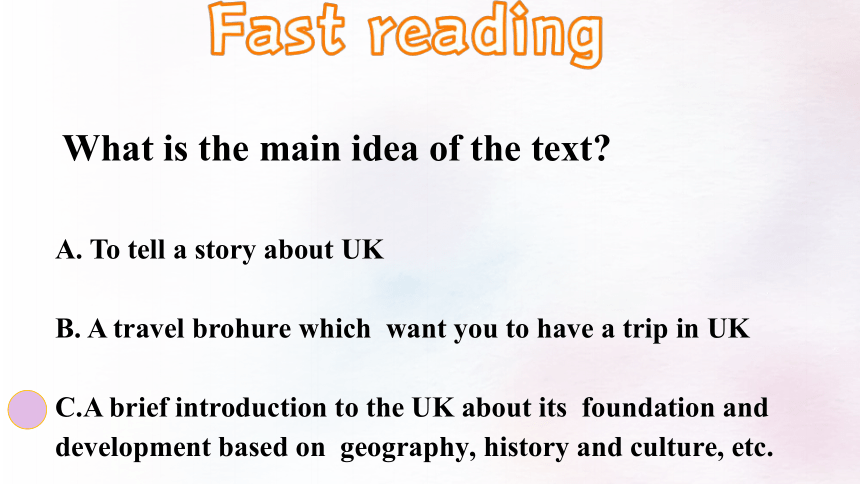
文档简介
(共28张PPT)
Unit 4
HISTORY AND TRADITIONS
1.学会区分地图
2.理解并悉知英国的历史及领土组成;
3.能够用英文做一个英国的简单介绍。
Lead in
administrative zoning map
resource map
What types of maps do you know?
Lead in
traffic map
weather map
topographic map
What types of maps do you know?
Great Britain
the United Kingdom
Its full name is the United Kingdom of Great Britain and Northern Ireland, commonly known as the United Kingdom (UK).
n. 王国;领域
What is the UK famous for
What comes to your mind when you think of the UK
some other tourist attractions
Big Ben
Buckingham Palace
St Paul's Cathedral
National Gallery
Windsor Castle
Hyde Park
What is the main idea of the text
A. To tell a story about UK
B. A travel brohure which want you to have a trip in UK
C.A brief introduction to the UK about its foundation and development based on geography, history and culture, etc.
Match each part of the text with its main idea.
Para. 1 Origins of the names
Para. 2 B. The four groups of people in the history of the UK
Para. 3 C. The similarities and differences of the four countries
Para. 4 D. Introduction of the topic.
Para. 5 E. More history and culture of the United Kingdom
1. What are the four countries of the United Kingdom Which two were the first to be joined together
The four countries of the United Kingdom are England, Wales, Scotland and Northern Ireland.
England and Wales were the first two to be joined together.
Read the text and answer the questions.
2. According to the text, what are two chief
advantages of studying the history of a
country
The two chief advantages of studying the history of a country are to help you understand more about the country and its traditions and to make visiting it more enjoyable.
adj. 最重要的;最高级别的
Read again to complete the timeline:
20th century
11th century
16th century
18th century
19th century
Romans arrived
Anglo-Saxons came
Vikings came
1st century
5th century
8th century
Normans came
Wales was joined
Scotland was joined
Ireland was added
Southern Ireland broke away
Sort out the information according to the timeline.
When What happened What changed
Romans arrived
Anglo-Saxons came
Vikings came
1th century
5th century
8th century
towns and roads
language and way houses were built
vocabulary and names of locations across the UK
When What happened What changed
11th century
16th century
18th century
Normans conquered England after the Battle of Hastings
castles built, legal system changed, and new words from French introduced
Wales was joined to Kingdom of England
Scotland was joined to England and Wales
“Kingdom of Great Britain formed/created”
vt. 占领;征服;控制
When What happened What changed
19th century
20th century
Ireland was added
the southern part of Ireland broke away
“United Kingdom of Great Britain and Ireland formed/created”
name changed to “United Kingdom of Great Britain and Northern Ireland”
Read the text carefully and find the same and different areas of the four countries of the UK.
The four countries The same areas The different areas
England Wales Scotland Northern Ireland The same flag —the Union Jack The same 1. _______________ The same 2. _______________ Education system
3. ______________
Traditions: 4. ____________ and national dish
Football team
currency
military defence
Legal system
national day
n. 通货;货币
n. 军事的;军用的
n. 防御;保卫
n. 法律的;合法的
The United Kingdom, Great Britain, Britain, England—many people are confused by what these different names mean. So what is the difference between them, if any Getting to know a little bit about British history will help you solve this puzzle.
In the 16th century, the nearby country of Wales was joined to the Kingdom of England. Later, in the 18th century, the country Scotland was joined to create the Kingdom of Great Britain. In the 19th century, the Kingdom of Ireland was added to create the United Kingdom of Great Britain and Ireland.
Finally, in the 20th century, the southern part of Ireland broke away from the UK, which resulted in the full name we have today: the United Kingdom of Great Britain and Northern Ireland. Most people just use the shortened name: “the United Kingdom” or “the UK”. People from the UK are called “British”, which means the UK is also often referred to as Britain or Great Britain.
The four countries that belong to the United Kingdom work together in some areas. They use the same flag, known as the Union Jack, as well as share the same currency and military defence. However, they also have some differences.
For example, England, Wales, Scotland, and Northern Ireland all have different education systems and legal systems. They also have their own traditions, like their own national days and national dishes. And they even have their own football teams for competitions like the World Cup!
The United Kingdom has a long and interesting history to explore, which can help you understand much more about the country and its traditions. Almost everywhere you go in the UK, you will be surrounded by evidence of four different groups of people who took over at different times throughout history.
The first group, the Romans, came in the first century. Some of their great achievements included building towns and roads. Next, the Anglo-Saxons arrived in the fifth century.They introduced the beginnings of the English language, and changed the way people built houses. The Vikings came in the eighth century, left behind lots of new vocabulary, and also the names of many locations across the UK.
The last group were the Normans. They conquered England after the well-known Battle of Hastings in the 11th century. They had castles built all around England, and made changes to the legal system. The Normans were French, so many French words slowly entered into the English language.
There is so much more to learn about the interesting history and culture of the United Kingdom. Studying the history of the country will make your visit much more enjoyable. The capital city London is a great place to start, as it is an ancient port city that has a history dating all the way back to Roman times.
There are countless historic sites to explore, and lots of museums with ancient relics from all over the UK. The UK is a fascinating mix of history and modern culture, with both new and old traditions. If you keep your eyes open, you will be surprised to find that you can see both its past and its present.
Unit 4
HISTORY AND TRADITIONS
1.学会区分地图
2.理解并悉知英国的历史及领土组成;
3.能够用英文做一个英国的简单介绍。
Lead in
administrative zoning map
resource map
What types of maps do you know?
Lead in
traffic map
weather map
topographic map
What types of maps do you know?
Great Britain
the United Kingdom
Its full name is the United Kingdom of Great Britain and Northern Ireland, commonly known as the United Kingdom (UK).
n. 王国;领域
What is the UK famous for
What comes to your mind when you think of the UK
some other tourist attractions
Big Ben
Buckingham Palace
St Paul's Cathedral
National Gallery
Windsor Castle
Hyde Park
What is the main idea of the text
A. To tell a story about UK
B. A travel brohure which want you to have a trip in UK
C.A brief introduction to the UK about its foundation and development based on geography, history and culture, etc.
Match each part of the text with its main idea.
Para. 1 Origins of the names
Para. 2 B. The four groups of people in the history of the UK
Para. 3 C. The similarities and differences of the four countries
Para. 4 D. Introduction of the topic.
Para. 5 E. More history and culture of the United Kingdom
1. What are the four countries of the United Kingdom Which two were the first to be joined together
The four countries of the United Kingdom are England, Wales, Scotland and Northern Ireland.
England and Wales were the first two to be joined together.
Read the text and answer the questions.
2. According to the text, what are two chief
advantages of studying the history of a
country
The two chief advantages of studying the history of a country are to help you understand more about the country and its traditions and to make visiting it more enjoyable.
adj. 最重要的;最高级别的
Read again to complete the timeline:
20th century
11th century
16th century
18th century
19th century
Romans arrived
Anglo-Saxons came
Vikings came
1st century
5th century
8th century
Normans came
Wales was joined
Scotland was joined
Ireland was added
Southern Ireland broke away
Sort out the information according to the timeline.
When What happened What changed
Romans arrived
Anglo-Saxons came
Vikings came
1th century
5th century
8th century
towns and roads
language and way houses were built
vocabulary and names of locations across the UK
When What happened What changed
11th century
16th century
18th century
Normans conquered England after the Battle of Hastings
castles built, legal system changed, and new words from French introduced
Wales was joined to Kingdom of England
Scotland was joined to England and Wales
“Kingdom of Great Britain formed/created”
vt. 占领;征服;控制
When What happened What changed
19th century
20th century
Ireland was added
the southern part of Ireland broke away
“United Kingdom of Great Britain and Ireland formed/created”
name changed to “United Kingdom of Great Britain and Northern Ireland”
Read the text carefully and find the same and different areas of the four countries of the UK.
The four countries The same areas The different areas
England Wales Scotland Northern Ireland The same flag —the Union Jack The same 1. _______________ The same 2. _______________ Education system
3. ______________
Traditions: 4. ____________ and national dish
Football team
currency
military defence
Legal system
national day
n. 通货;货币
n. 军事的;军用的
n. 防御;保卫
n. 法律的;合法的
The United Kingdom, Great Britain, Britain, England—many people are confused by what these different names mean. So what is the difference between them, if any Getting to know a little bit about British history will help you solve this puzzle.
In the 16th century, the nearby country of Wales was joined to the Kingdom of England. Later, in the 18th century, the country Scotland was joined to create the Kingdom of Great Britain. In the 19th century, the Kingdom of Ireland was added to create the United Kingdom of Great Britain and Ireland.
Finally, in the 20th century, the southern part of Ireland broke away from the UK, which resulted in the full name we have today: the United Kingdom of Great Britain and Northern Ireland. Most people just use the shortened name: “the United Kingdom” or “the UK”. People from the UK are called “British”, which means the UK is also often referred to as Britain or Great Britain.
The four countries that belong to the United Kingdom work together in some areas. They use the same flag, known as the Union Jack, as well as share the same currency and military defence. However, they also have some differences.
For example, England, Wales, Scotland, and Northern Ireland all have different education systems and legal systems. They also have their own traditions, like their own national days and national dishes. And they even have their own football teams for competitions like the World Cup!
The United Kingdom has a long and interesting history to explore, which can help you understand much more about the country and its traditions. Almost everywhere you go in the UK, you will be surrounded by evidence of four different groups of people who took over at different times throughout history.
The first group, the Romans, came in the first century. Some of their great achievements included building towns and roads. Next, the Anglo-Saxons arrived in the fifth century.They introduced the beginnings of the English language, and changed the way people built houses. The Vikings came in the eighth century, left behind lots of new vocabulary, and also the names of many locations across the UK.
The last group were the Normans. They conquered England after the well-known Battle of Hastings in the 11th century. They had castles built all around England, and made changes to the legal system. The Normans were French, so many French words slowly entered into the English language.
There is so much more to learn about the interesting history and culture of the United Kingdom. Studying the history of the country will make your visit much more enjoyable. The capital city London is a great place to start, as it is an ancient port city that has a history dating all the way back to Roman times.
There are countless historic sites to explore, and lots of museums with ancient relics from all over the UK. The UK is a fascinating mix of history and modern culture, with both new and old traditions. If you keep your eyes open, you will be surprised to find that you can see both its past and its present.
